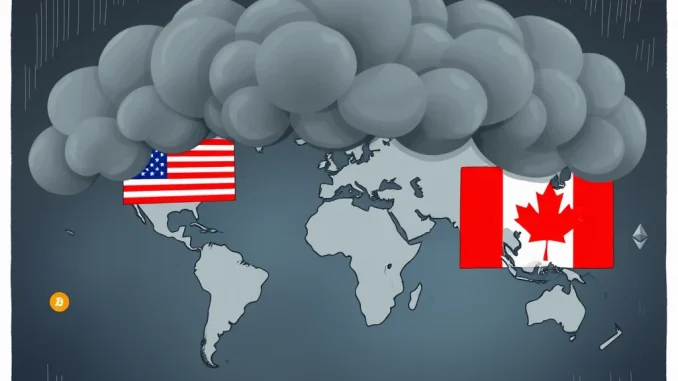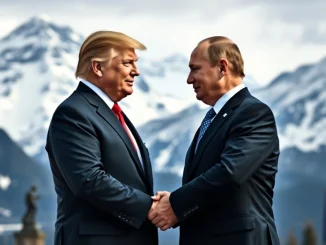
Hold onto your hats, crypto enthusiasts! The economic rollercoaster just got a potential new loop. Former U.S. President Donald Trump is once again wielding the threat of tariffs, this time targeting the European Union and Canada. But what does this mean for the volatile world of cryptocurrency? Let’s dive into the potential fallout and what you need to know.
Trump Tariffs: A Blast from the Past?
Donald Trump, known for his ‘America First’ trade policies, has taken to Truth Social to voice concerns about alleged economic harm caused by the EU and Canada. He’s warning of “significantly higher tariffs than currently planned” if these allies don’t play ball. This isn’t the first time we’ve seen Trump use tariffs as a negotiating tactic, and the mere mention of them sends ripples through global markets.
Why should crypto investors care about Trump tariffs?
- Market Volatility: Tariffs introduce uncertainty into the global economy. Uncertainty often translates to market volatility, and cryptocurrency markets are notoriously sensitive to broader economic sentiment. Fear of trade wars can trigger sell-offs in traditional markets, and crypto often follows suit, at least initially.
- Dollar Strength: Historically, trade disputes and tariffs can impact the value of the US dollar. A stronger dollar can sometimes negatively correlate with Bitcoin and other cryptocurrencies, although this relationship isn’t always consistent and is influenced by many factors.
- Global Economic Slowdown: Escalating trade tensions can contribute to a global economic slowdown. A weaker global economy can impact investment appetite across all asset classes, including cryptocurrencies. Investors might become more risk-averse and pull back from speculative assets.
- Inflationary Pressures: Tariffs can lead to higher prices for imported goods, potentially contributing to inflation. While some argue Bitcoin can be an inflation hedge, the immediate market reaction to tariff announcements is often negative risk-off sentiment.
EU Trade and Canada Trade Under Fire: What’s the Beef?
While Trump’s Truth Social post is light on specifics regarding the “economic harm” caused by the EU and Canada, it’s worth recalling past trade disputes. Under his previous administration, the U.S. engaged in tense trade negotiations with both the EU and Canada, particularly concerning:
- Steel and Aluminum Tariffs: Trump previously imposed tariffs on steel and aluminum imports from both regions, citing national security concerns. These tariffs were met with retaliatory measures.
- Agricultural Products: Trade in agricultural goods has often been a sticking point, with disputes over market access and subsidies.
- Automobiles: The auto industry has been another area of trade friction, with the U.S. seeking to protect domestic manufacturers.
It remains to be seen which specific issues Trump is referencing now. However, the threat of “significantly higher tariffs” suggests a potentially aggressive stance if he were to regain office.
Decoding the Global Economy Impact
Let’s break down the potential consequences of these tariff threats on the global economy:
| Impact Area | Potential Consequence | Crypto Market Implication |
|---|---|---|
| Increased Trade Costs | Tariffs raise the cost of goods traded between the U.S., EU, and Canada, potentially leading to higher consumer prices and reduced business profitability. | Inflationary pressures could theoretically support Bitcoin as an inflation hedge in the long term, but short-term market fear and uncertainty could dominate. |
| Retaliatory Tariffs | The EU and Canada are likely to retaliate with tariffs on U.S. goods, escalating trade tensions and harming businesses on all sides. | Increased global economic uncertainty and risk aversion could lead to investors pulling back from all markets, including crypto. |
| Supply Chain Disruptions | Tariffs can disrupt global supply chains, making it more difficult and expensive for businesses to operate efficiently. | Supply chain issues can contribute to inflation and economic slowdown, further fueling market volatility and potentially impacting crypto sentiment. |
| Reduced Economic Growth | Escalating trade disputes can dampen economic growth globally as businesses reduce investment and consumers become more cautious. | A weaker global economy generally isn’t positive for risk assets like cryptocurrencies. Reduced liquidity and investment appetite can weigh on crypto prices. |
Market Uncertainty: The Crypto Investor’s Challenge
For cryptocurrency investors, the biggest immediate concern is market uncertainty. Trump’s tariff threats add another layer of complexity to an already turbulent economic landscape. Here’s how to navigate this uncertainty:
- Stay Informed: Keep a close eye on news developments regarding trade relations and tariff announcements. Reputable financial news sources and crypto news platforms are crucial.
- Manage Risk: In times of uncertainty, risk management is paramount. Consider diversifying your portfolio, adjusting your position sizes, and using stop-loss orders if appropriate for your trading strategy.
- Long-Term Perspective: Remember that cryptocurrency markets are inherently volatile. Short-term market reactions to tariff news may be dramatic, but long-term trends are influenced by a multitude of factors beyond trade policy.
- Fundamental Analysis: Focus on the fundamentals of the cryptocurrencies you hold. Strong projects with solid technology and growing adoption are more likely to weather economic storms.
Actionable Insights: Preparing for Potential Tariff Fallout
While we can’t predict the future with certainty, here are some actionable steps crypto investors can consider:
- Scenario Planning: Consider different scenarios – tariffs implemented, tariffs avoided, trade tensions escalate, trade tensions ease. Think about how your crypto portfolio might perform in each scenario and adjust your strategy accordingly.
- Dollar-Cost Averaging: In volatile markets, dollar-cost averaging (DCA) can be a less stressful approach than trying to time the market. Regularly investing a fixed amount can smooth out price fluctuations over time.
- Cash is King (Sometimes): In periods of high uncertainty, holding some cash (or stablecoins) can provide flexibility to buy dips if market corrections occur.
- HODL with Caution: While long-term holding (HODLing) is a common crypto strategy, be prepared for potential short-term volatility and consider whether your risk tolerance aligns with the current market environment.
Conclusion: Navigating the Tariff Terrain
Donald Trump’s warning of significant tariffs adds another layer of complexity to the global economic outlook. For cryptocurrency markets, this translates to increased market uncertainty and the potential for volatility. While the long-term impact on crypto is multifaceted and depends on broader economic trends, in the short term, investors should brace for potential market fluctuations. Staying informed, managing risk, and maintaining a long-term perspective are key to navigating these potentially turbulent times. The crypto journey is rarely smooth, and tariff threats are just another bump in the road – or perhaps a significant pothole – that we must learn to navigate.



